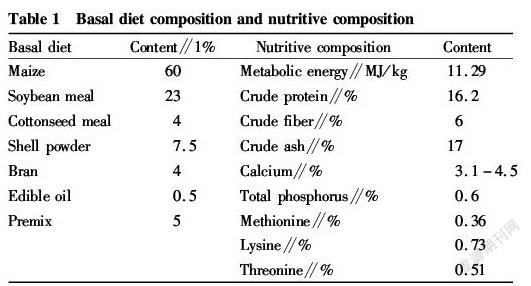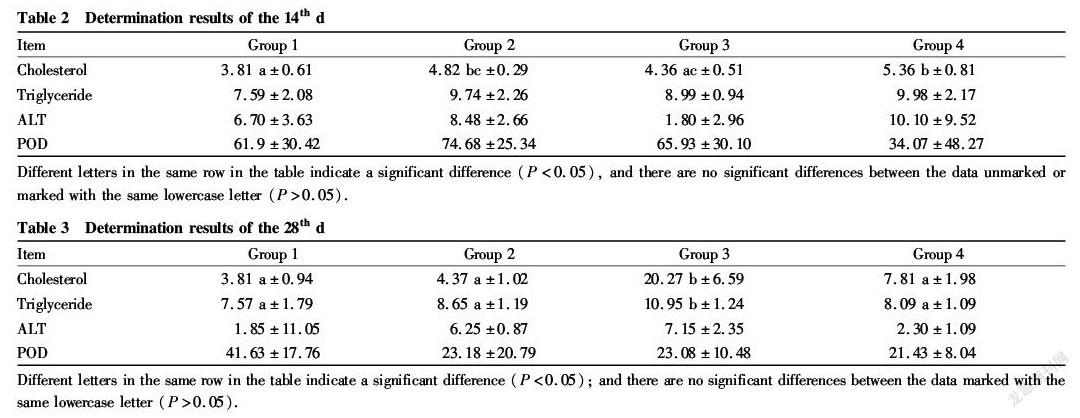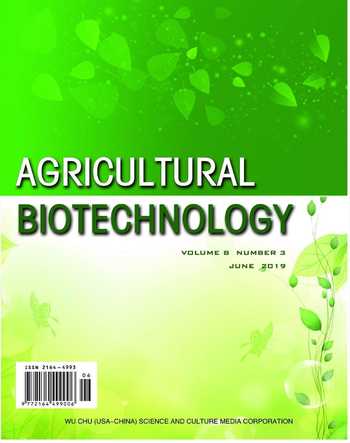Effects of Probiotics and Enzyme Preparation on Cholesterol Triglyceride and Serum ALT and POD in Egg Yolks
2019-09-10JiaoLIYuanqingZHONGYihaoZHANGJintangLUODongxuWANGYiqiZHANGSuohuaZHAO
Jiao LI Yuanqing ZHONG Yihao ZHANG Jintang LUO Dongxu WANG Yiqi ZHANG Suohua ZHAO


Abstract [Objectives] This study was conducted to investigate the effects of probiotics and enzyme preparation on cholesterol, triglyceride and serum alanine aminotransferase (ALT) and peroxidase (POD) in egg yolks.
[Methods] Forty eight 450 day old Hyline brown hens were randomly divided into 4 groups with 3 replicates in each group and 4 individuals in each replicate. Group 1 as the control check (CK) group was fed the basal diet; group 2 was fed the basal diet with the addition of 150 g/t of probiotics; group 3 was the basal diet +200 g/t lipase group; and group 4 was fed the basal diet with the addition of 150 g/t of probiotics and 200 g/t of lipase. The preliminary trial period was 10 d, and the trial period was 30 d.
[Results] The contents of cholesterol and triglyceride in the egg yolks of the test groups supplemented with the probiotics and enzyme preparation were higher than those of the CK. On the 14 th day of treatment, the cholesterol contents in the egg yolks of group 2 and group 4 were significantly higher than that of group 1 (P<0.05). On the 28 th day of treatment, the contents of cholesterol and triglyceride in the egg yolks of the three test groups were significantly higher than those in group 1 (P<0.05). There were no significant differences in serum ALT and POD between various groups (P>0.05).
[Conclusions] The addition of probiotics and enzyme preparations to the feed of laying hens can increase the contents of cholesterol and triglyceride in egg yolks, without significantly affecting serum ALT and POD.
Key words Probiotics; Enzymic preparation; Laying hens; Yolk cholesterol; Triglyceride; ALT; POD
Probiotics and enzyme preparations are the main micro ecological preparations added to livestock and poultry feed. Their action mechanism is to regulate the micro ecological environment of the intestines of livestock and poultry, promote the digestion and absorption of nutrients and improve the immunity of animals, to thereby improve the production performance of livestock and poultry[1-4]. Adding lipase to broiler feed can not only promote broiler growth, but also reduce abdominal fat[5-6]. Microbial derived lipase can reduce cholesterol in broiler serum and improve transport efficiency in lipid metabolism[7]. In addition to emulsifying fat, bile acid can promote digestion and absorption of lipids in the intestines, and can also maintain animal health by regulating glycolipid metabolism[8], thereby improving the slaughter performance of broilers[9].
Cholesterol and triglyceride in egg yolks are mainly derived from liver lipid metabolism. Serum ALT is an important indicator of liver function. Serum POD can reduce the formation of lipid peroxide, remove free radicals in the body, and enhance the bodys ability to resist oxidative damage. Jin[10] and Xu et al.[11] found that probiotics have important significance in the prevention and control of fatty liver in medical research. In intensive farming environment, laying hens are prone to fatty liver syndrome which affects egg production performance during the peak of egg production, especially when feeding high energy and low protein diets. There are few reports on the effects of probiotics and enzyme preparations on liver function and egg yolk lipid content of laying hens. In this study, probiotics and an enzyme preparation were added to the feed of laying hens to investigate the effects of these two kinds of microecological preparations on cholesterol, triglyceride and serum ALT and POD in egg yolks and further analyze the effects of probiotics and enzyme preparations on liver lipid metabolism in laying hens.
Materials and Methods
Experimental animals and additives
The test animals were 450 day old Hyline brown hens, purchased from a laying hen farm in Tianjin. The probiotics (the main ingredient was Bacillus) and enzyme preparation (mainly composed of lipase and bile acid) were donated by Kunming Baijia Yikang Biotechnology Co., Ltd.
Main instruments and reagents
LD5 2A centrifuge, Liaoning Saiyasi Science and Technology Co., Ltd.; thermo and DRAGON pipette; UA 6100 UV spectrophotometer, Shanghai Meipuda; biochemical incubator, Jinan Hui Xie Medical Equipment Co., Ltd.; cholesterol, triglyceride, ALT and POD kits, purchased from Nanjing Jiancheng Bioengineering Institute.
Basal diet composition and nutritional level
The basal diet was prepared according to the Chinese Feeding Standard (2004) of Poultry. The basal diet composition and nutritional level are shown in Table 1.
Experimental design
Forty eight 450 day old Hyline brown hens with uniform weight were randomly divided into 4 groups with 3 replicates in each group and 4 individuals in each replicate. Group 1 as the control check group (CK) was fed the basal diet; group 2 was fed the basal diet with the addition of 150 g/t of probiotics; group 3 was the basal diet +200 g/t lipase group; and group 4 was fed the basal diet with the addition of 150 g/t of probiotics and 200 g/t of lipase. The preliminary trial period was 10 d, and the experimental period was 30 d.
Feeding and management
The feeding experiment was carried out in the experimental farm. The chicken house was built in three layers, and the hens were raised with manual feeding, free drinking, manual feces removal and manual egg picking. The numbers of eggs and broken eggs were recorded every day.
Inspection items and methods
Determination of yolk cholesterol and triglyceride
On the 14 th and the 28 th d of treatment, 6 eggs laid on the very day were broken and poured into a 9 cm clean petri dish, respectively. Each egg was extracted with a syringe for 1 ml of egg yolk, which was added into a clean test tube. Then, 9 ml of anhydrous ethanol was added, followed by stirring and mixing. Each mixture was centrifuged at 2 500 r/min for 10 min. The supernatant was extracted and measured with a kit and an ultraviolet spectrophotometer for the contents of cholesterol and triglyceride in the egg yolks.
Determination of serum ALT and POD
Six hens were randomly selected from each group on the 14 th and the 28 th d of treatment, and blood was collected from the wing veins. The blood was incubated in a 37 ℃ biochemical incubator for 30 min, and then centrifuged at 2 500 r/min for 10 min. The serum was separated and assayed using a kit and an ultraviolet spectrophotometer, obtaining the serum ALT and POD values.
Data processing
Statistical analysis was performed using Excel 2007. One way ANOVA was performed using spss 17.0, and the differences between the mean values of various treatments were tested by Duncan method, in which P<0.05 indicates a significant difference. The results were expressed as "mean±standard deviation".
Results and Analysis
Determination results of the 14 th d and analysis
It can be seen from Table 2 that the cholesterol contents in egg yolks of test group 2 (added with the probiotics) and test group 4 (added with the probiotics plus the enzyme preparation) increased on the 14 th d of treatment, and were significantly different from that in the egg yolks of the CK was significantly different (P<0.05). The cholesterol content in the egg yolks of test group 3 (with the addition of the enzyme preparation) was higher than that of the CK, but the difference was not significant (P>0.05). The content of triglyceride was higher in the egg yolks of the various experimental treatments than in the egg yolks of the CK, but the differences were not significant (P>0.05). There were no significant differences in serum ALT and POD contents between the experimental groups and the CK (P>0.05). It indicated that the addition of the probiotics and enzyme preparation to the feed can improve the contents of cholesterol and triglyceride in egg yolks, without significantly affecting serum ALT and POD.
Determination results of the 28 th d and analysis
It can be seen from Table 3 that the contents of cholesterol and triglyceride in the egg yolks of test group 3 (with the addition of enzyme preparation) were significantly higher than those of the CK (P<0.05). The contents of cholesterol and triglyceride in test group 2 (added with the probiotics) and test group 4 (added with the probiotics plus the enzyme preparation) were higher than those in test group 1, but the differences were not significant (P>0.05). There were no significant differences in serum ALT and POD between the experimental groups and the CK (P> 0.05). It indicated that the addition of the enzyme preparation in the feed can significantly increase the contents of cholesterol and triglyceride in egg yolks, but had no significant effects on serum ALT and POD.
Discussion and Conclusions
Effects of the probiotics on yolk cholesterol and triglyceride and serum ALT and POD
The results of this study showed that the contents of cholesterol and triglyceride increased in the egg yolks of the laying hens fed with the addition of probiotics, and the cholesterol content increased significantly in the yolks when the probiotics was applied for 14 d. Triglyceride and cholesterol are the most important nutritive substances in egg yolks, and adding probiotics to feed can increase the contents of lipids in egg yolks, which is consistent with the results of Du et al.[12]. However, the optimal contents of cholesterol and triglyceride in egg yolks and the dose effect relationships with different probiotics need further study. The ALT and POD in the serum of the laying hens were within the normal range during the whole test period, which also showed that the probiotics had no adverse effects on liver function.
Effects of the enzyme preparation on yolk cholesterol and triglyceride and serum ALT and POD
In this study, the contents of cholesterol and triglyceride in egg yolks increased in the groups added with the enzyme preparation, which showed a significant increase in egg yolks on the 28 th d of application, indicating the active ingredients lipase and bile acid in the enzyme preparation can provide more raw material resources for the synthesis of cholesterol and triglyceride in the liver by promoting the digestion and absorption of lipids in feed. Wang et al.[8] found in their study on the nutritional and physiological effects of bile acid that a proper concentration of fatty acids helps the digestion and absorption of lipids in intestines. These results show that the addition of enzyme preparations to the feed can promote the improvement of cholesterol and triglyceride in egg yolks, without significantly affecting serum ALT and POD.
Agricultural Biotechnology2019
References
[1] WANG XF, YAN M, JIANG Y, et al. Effects of microecological preparations on production performance and egg quality of hyline brown[J]. China Poultry, 2017, 39(23): 73-75. (in Chinese)
[2] SUN L. Effect and interaction of probiotics and Zn Met on production performance, egg quality and antioxidant performance of layers[D]. Shenyang: Shenyang Agricultural University, 2017. (in Chinese)
[3] ZHANG X. Effects of different kinds of probiotics on serum biochemical parameters antioxidative, caeucm microorganismability and antioxidant ability of blue shell chicken[D]. Jilin: Yanbian University, 2016. (in Chinese)
[4] WU HR, CHENG FL, SONG X, et al. Advances in the application of microecological preparations in laying hen production[J]. Feed Additive, 2016(19): 40-43. (in Chinese)
[5] GONG JY, LI FL, SHAN AS, et al. Influences of lipase supplemented in diets on growth performance, serum biochemical parameters and abdominal fat rate of white broilers[J]. Feed Industry, 2015, 41(14): 41-45. (in Chinese)
[6] MA QS, DING XM, BAI SP, et al. Lipase: Effects on growth performance and nutrient availability of broilers[J]. Acta Zoonutrimenta Sinica, 2013, 25(10): 2447-2458. (in Chinese)
[7] YE H, LEI JP, FENG DY, et al. Effects of different microbial lipases on growth performance, serum biochemical indices, and pectoral muscle nutrients of yellow feathered broilers[J]. Journal of South China Agricultural University, 2013, 34(3): 399-404. (in Chinese)
[8] WANG P, LIN S, WU D, et al. Advances in studies on nutritional and physiological functions and metabolic regulation of bile acid[J]. Acta Zoonutrimenta Sinica, 2019, 31(5): 1-10. (in Chinese)
[9] CHENG WW, WANG SK, WANG JS, et al. Effects of dietary bile acids on production performance, serum biochemical index and slaughter performance in broilers[J]. China Poultry, 2017, 39(3): 31-35. (in Chinese)
[10] JIN P. Effect of probiotics on lipopolysaccharide induced hepatic pro inflammatory cytokine expression and liver damage in mice[D]. Hangzhou: Zhejiang University, 2015. (in Chinese)
[11] XU YS, XIE HL, ZHU MJ, et al. The efficacy of probiotics on nonalcoholic fatty liver disease: A meta analysis [J]. Chinese Journal of Microecology, 2019, 31(1): 40-47. (in Chinese)
[12] DU XH, XIONG T, LIU JY, et al. Relationship between serum/yolk cholesterol content and egg traits in hens of 300 days age[J]. China Poultry, 2013, 35(11): 11-14. (in Chinese)
杂志排行
农业生物技术(英文版)的其它文章
- Study on Chemical Composition of the Ethyl Acetate Extract of Pratia
- Effects of Different Selenium Fertilizer Types on Selenium Content and Quality of “Lingfeng” Grapes
- Protoplast Culture and Its Application in Fruit Breeding
- Indexes of Tree Structure of Cylindrical Pear Orchards at the Sapling Stage
- Carbon Storage and Distribution of the Mature Pinus massoniana Plantation in Northwest Guangxi
- Pollution and Quality Control of Mycotoxins in Foods and Feeds
